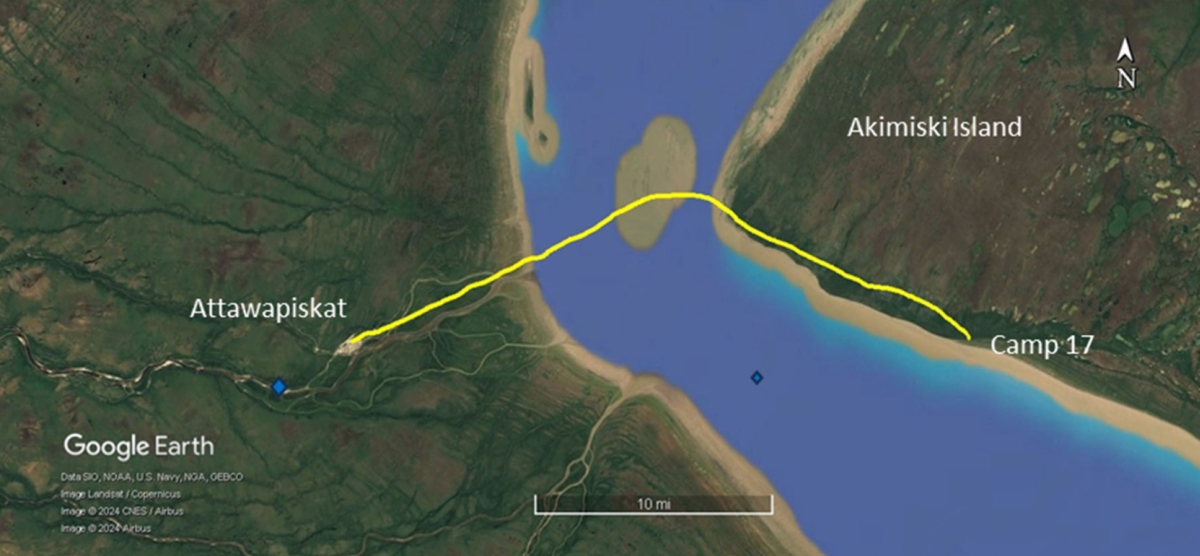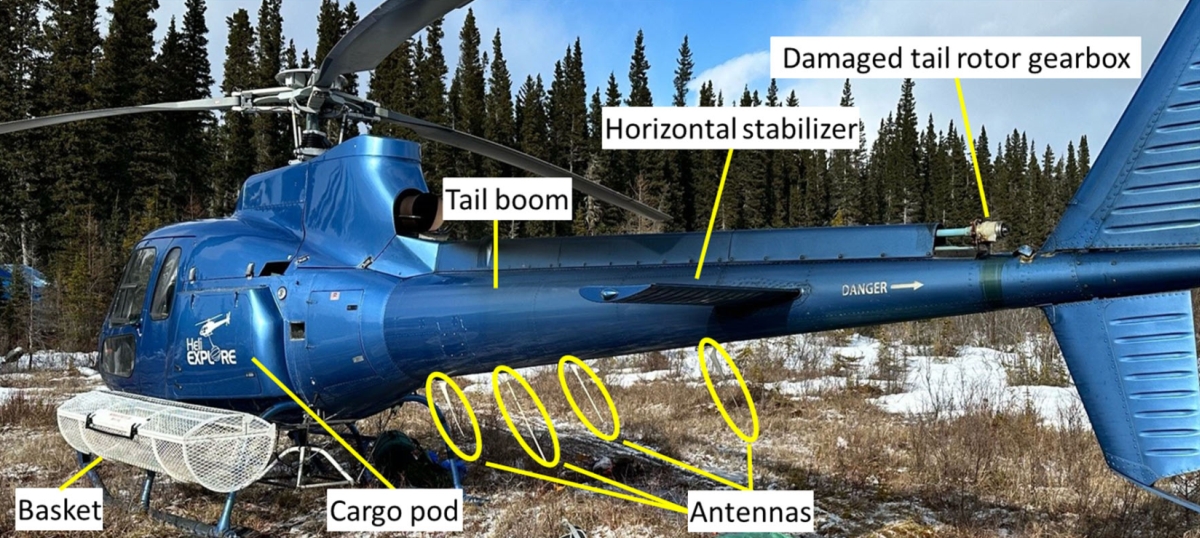Tail rotor strike during ground handling
Heli Explore Inc.
Aerospatiale AS-350 BA (helicopter), C-GWMO
Akimiski Island, Nunavut
The Transportation Safety Board of Canada (TSB) investigated this occurrence for the purpose of advancing transportation safety. It is not the function of the Board to assign fault or determine civil or criminal liability. This report is not created for use in the context of legal, disciplinary or other proceedings. See Ownership and use of content. Masculine pronouns and position titles may be used to signify all genders to comply with the Canadian Transportation Accident Investigation and Safety Board Act (S.C. 1989, c. 3).
History of the flight
On 21 April 2024, the pilot of the AerospatialeThe current type certificate holder is Airbus Helicopters. AS350 BA helicopter (registration C-GWMO, serial number 1879), operated by Heli Explore Inc., was conducting a series of flights from Attawapiskat Airport (CYAT), Ontario, to various hunting camps located around Attawapiskat and on nearby Akimiski Island, Nunavut, under visual flight rules. The flights were in support of the annual goose hunt, carrying passengers and gear to and from various camps.
The pilot began his duty day at approximately 0930All times are Eastern Daylight Time (Coordinated Universal Time minus 4 hours). and conducted 8 flights before the occurrence flight.
At approximately 1650, the helicopter arrived back at CYAT from Camp 17, which is located on the southwest shore of Akimiski Island (Figure 1), to pick up 1 passenger and some gear for a return flight to Camp 17.

When the helicopter arrived at CYAT, the passenger and gear were ready for pick up. The pilot stayed in the helicopter with the engine running and rotors turning while a Heli Explore Inc. aircraft maintenance engineer providing ground support and the passenger loaded the gear into externally accessible cargo pods on both the left and right sides of the helicopter fuselage behind the cabin, and in an external cargo basket attached to the left skid of the landing gear. When loading was complete, the aircraft maintenance engineer escorted the passenger to the helicopter; the passenger got in the front-left seat beside the pilot and fastened his 4-point safety belt. The helicopter departed at approximately 1705 for Camp 17.
The flight to Camp 17 was approximately 15 minutes long and the helicopter landed within a few hundred feet of the camp. The landing area was free of obstructions, with long grass, icy patches, and minimal snow cover.
The pilot landed facing the northeast, where he could see the trail leading to the camp. He left the engine running and rotors turning and his hands remained on the controls. This technique was often used during ground handling (passenger and cargo loading and off loading) to allow for a swift reaction if the helicopter were to shift or become unstable on the landing area.
An individual on a snowmobile towing a sled arrived to help unload the helicopter. He waited off to the left side of the helicopter, in view of the pilot, until the pilot gave a signal that he could move closer. The pilot told the passenger he could get out of the helicopter and signalled to the snowmobile driver that he could approach the helicopter. The snowmobile and sled were parked near the external cargo basket on the left side, facing the same direction as the helicopter, where it remained throughout the occurrence. The passenger exited the helicopter and refastened the safety belt before closing the front door.
The passenger and the snowmobile driver began unloading and transferring the contents of the basket and left-side cargo pod into the sled. As the passenger completed unloading the cargo pod, the snowmobile driver walked around the front of the helicopter to unload the right-side pod. Once the passenger emptied the cargo pod, he secured its door and started walking toward the tail of the helicopter.
The snowmobile driver saw that the passenger was approaching the back of the helicopter, and tried to warn him by yelling and gesturing for him to stay away from the back of the helicopter. The passenger continued along the left side of the tail boom toward the back of the helicopter, past 4 antennas mounted below the tail boom, and past the left-side horizontal stabilizer (Figure 2). He then ducked under the tail boom, aft of the horizontal stabilizer, but forward of the tail’s vertical fin. As he crossed to the right side, he was struck by the spinning tail rotorWhen a helicopter’s tail rotor is spinning, it is difficult, if not impossible, to see. and was fatally injured. The impact caused the tail rotor and most of the tail rotor gearbox to detach from the helicopter.

The pilot felt an impact and severe vibration in the helicopter; he also saw the snowmobile driver backing away from the helicopter with a panicked look. The pilot immediately shut down the engine, brought the main rotor to a stop, exited the helicopter, saw what had happened, and called Heli Explore Inc. for help using a satellite phone.
Pilot information
The pilot held the appropriate licence and ratings to conduct the occurrence flight in accordance with existing regulations; he held a Commercial pilot licence – helicopter and a valid medical certificate. He had accumulated over 2000 hours of total flight time and approximately 1686 hours on type. The pilot had been hired by Heli Explore Inc. in March 2022.
There was no indication that the pilot’s performance was affected by medical or physiological factors.
Annual goose hunt
Every year, a goose hunt, referred to as Goose Break, is held in various parts of northern Canada. As an alternative to ground transportation over potentially unfrozen or unsafe waterways, communities often use helicopters to transport community members to and from their hunting camps. Since 2022, Heli Explore Inc. has supported the community of Attawapiskat in the annual Goose Break. In 2024, 2 helicopters were used and approximately 300 community members were transported to various camps during the 1st week of the Goose Break.
Safety briefings and safety information
The Canadian Aviation Regulations (CARs) state that “[t] he pilot-in-command shall ensure that passengers are given a safety briefing in accordance with the Commercial Air Service Standards.”Transport Canada, SOR/96-433, Canadian Aviation Regulations, subsection 703.39(1). According to the Commercial Air Service Standards, the safety briefing must include, among other elements, the “safest direction and most hazard-free route for passenger movement away from the helicopter, and any dangers associated with the helicopter, such as pitot tube locations, tail rotor and main rotor.”Ibid., Standard 723: Air Taxi: Helicopters, paragraph 723.39(1)(d). This requirement is also included in the Heli Explore Inc. operations manual.Heli Explore Inc., Operations Manual: VFR Operations, Aerial Work (702) & Air Taxi (703), Manual #1, Issue 2, Amendment 6 (06 December 2022), section 4.17: Passenger Briefing, item (4)a), p. 4-33.
In previous years at Attawapiskat, a person employed by Heli Explore Inc. arranged passenger bookings and provided safety briefings to passengers. This method served several purposes: it was a means of documenting that passengers had received the safety briefing; it helped accommodate the language needs of the passengers, some of whom speak only Cree; and it helped speed up the process of moving many passengers to the various camps.
According to the Heli Explore Inc. operations manual, following the safety briefing, passengers have to sign a form that indicates the general safety procedures to be followed for helicopter flights. The first section of the form, relating to how to approach and move away from the helicopter with the engine running and rotors turning, includes the statement: “Never approach the rear of aircraft (dangers from tail rotor).”Heli Explore Inc., Helicopter Safety Briefing form. The signed form is required to be given to the pilot to confirm that the passengers have received a safety briefing.
Given that it had been common practice in previous years for the person booking the flights to give the safety briefing to passengers, the pilot assumed that this had been done. On the day of the occurrence, the passenger embarked in the helicopter without receiving any safety briefing. However, the passenger had flown by helicopter numerous times to and from the camps, and he had been informed on those occasions that he should stay away from the rear of the helicopter, especially from the tail rotor.
Safety action taken
Following the accident, Heli Explore Inc. required that pilots shut down the engine while disembarking passengers for the remainder of the Goose Break flights during that season.
The company has revised its passenger guidance to provide more information and to warn of the danger of going near the back of a helicopter.
Safety messages
Pilots are reminded to ensure that all passengers and ground personnel are briefed on and understand the hazards of helicopter danger areas, especially the tail rotor, when moving about a helicopter with its engines running and rotors turning.
Passengers and ground personnel are reminded to be vigilant of the hazards of helicopter danger areas when moving about a helicopter with its engines running and with rotors turning.
This report concludes the Transportation Safety Board of Canada’s investigation into this occurrence. The Board authorized the release of this report on 29 January 2025. It was officially released on 12 February 2025.

